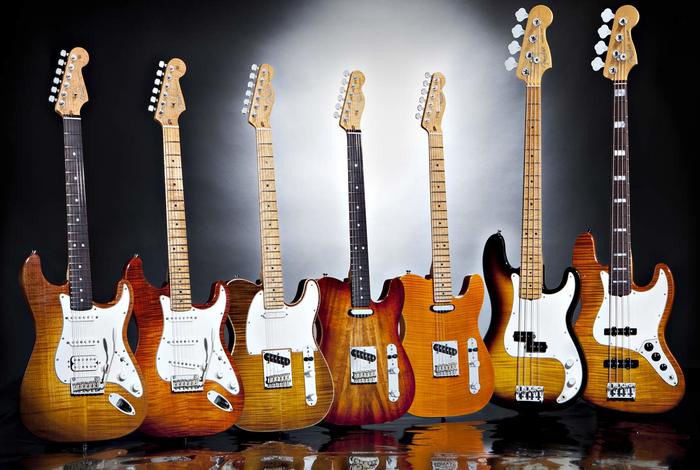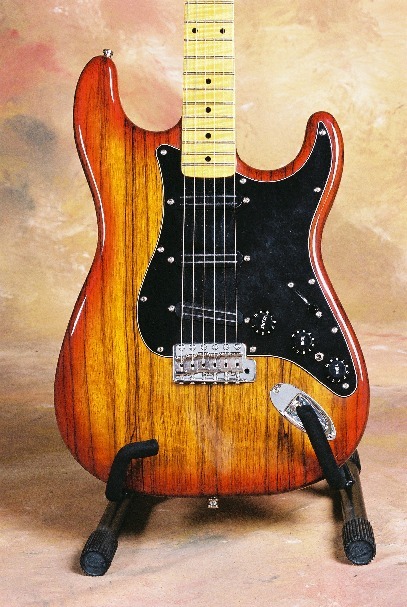Belle gratte land
- 81 435 réponses
- 878 participants
- 7 186 388 vues
- 759 followers
roman66
venez poster la photo de la guitare de vos rêves.
Pour commencer, je fais dans le simple, le basique, le classique...

Barry Centre
Heu, j'ai voulu dire "assez méconnu", ou "assez peu connu"....m'enfin, z'aviez tous compris, hein...
Barry Centre (jeu de mots)
sonicsnap
Les trois Strato (la blanche, la rouge et la walnut) sont toutes très belles. Mais la walnut est effectivement particulièrement somptueuse. ![]()
![]()
![]() Je me demande si le noyer donne un son particulier?? D'autre part, je vois que la tête est sombre (ce qui rend très bien du point de vue esthétique): Est-ce à dire que le manche est de la même essence?
Je me demande si le noyer donne un son particulier?? D'autre part, je vois que la tête est sombre (ce qui rend très bien du point de vue esthétique): Est-ce à dire que le manche est de la même essence?
Barry Centre
Les trois Strato (la blanche, la rouge et la walnut) sont toutes très belles. Mais la walnut est effectivement particulièrement somptueuse. Je me demande si le noyer donne un son particulier?? D'autre part, je vois que la tête est sombre (ce qui rend très bien du point de vue esthétique): Est-ce à dire que le manche est de la même essence?
Pour le manche, je saurais pas trop te dire, c'est dur de retrouver les specs d'une série de strats aussi confidentielle (et pas récente : début des années 80). Mais il me semble avoir lu qq part que c'est aussi du noyer.
Et pour le noyer en tant que bois pour le corps, tu trouves ceci :
Walnut. Dense and fairly heavy, with sonic characteristics similar to those of mahogany, walnut is occasionally used in electric-guitar bodies. It tends to be warm and full, but usually with a firmer low end, and more overall tightness. Walnut’s rich brown color and often pleasing grain patterns means it looks good under a simple coat of translucent lacquer.
Ou encore :
Juglans regia/nigra
Walnut is exactly the right color for a guitar. Even the plain stuff is pretty, and figured walnut is a favorite wood. It machines wonderfully, bends like a dream (except the unpredictable fiddleback samples), is easy to find. Walnut is an excellent tonewood falling sonically between the warm dark sounds of East Indian Rosewood and the bright bell-like ring of Maple. Both Black Walnut and Claro Walnut are used, and many sets contain fantastic flamed figure, occasionally with strongly contrasting sap wood for a beautiful overall look. Walnut is also found in South America, Africa. The looks and characteristics of all of them vary somewhat.
It is hard to find an alternative to maple though tonally, many have had similar results with Californian (Claro) walnut.(Juglans California) Walnut is primarily dark gray in color and can also exhibit dramatic figuring. This rich brown colored wood offers a sound that falls somewhere between Indian Rosewood and Mahogany. It gives the woody sound of Mahogany, but also adds some of the bottom end of Rosewood. Less color to both bass and treble than mahogany. Has a spicy aroma.
Some are markedly less enthused about the tonal properties of most of the claro walnut instruments though they acknowledge that it's often quite visually attractive. It works as easily or more so than any other wood used in building.
Black Walnut is softer and less dense than rosewood and mahogany but is still very resonant. This wood has proven itself as a tonewood with large manufacturers and custom builders alike. Similar in density and grain structure to Hawaiian Koa. Black Walnut yields excellent balance with tonal characteristics that fall between Mahogany and Rosewood. The trebles have a unique earthy tone which records very distinctively. Often recommended for a flatpicked sound and mellow fingerstyle playing. With its rich brown color and occasional steaks. Black Walnut has a stripy appearance somewhat like Indian Rosewood.
The sapwood of black walnut is nearly white, while the heartwood is light brown to dark, chocolate brown, often with a purplish cast and darker streaks. The wood is heavy, hard, and stiff and has high shock resistance. Black walnut is straight grained and easily worked with hand tools and by machine. It finishes beautifully and holds paint and stain exceptionally well. It also glues and polishes well.
Walnut Is dark brown in color with a lot of figure and flame. An all-walnut guitar provides rich and warm bass with plenty of crispness on the mid and treble side. Walnut offers high value for money, with the beauty and visual impact of an all Koa guitar, but at a much lower price. Walnut Is a dark brown, highly figured specialty wood which is grown in a wide variety of locations. It provides the bright woodiness of mahogany when played lightly and much of the power of rosewood when you dig in. When properly braced, a walnut backed guitar can have a unique warmth and tonal depth.
Wade Hampton Miller: “My comparison of the sound of claro with the sound of cherry is probably the most accurate in terms of getting an idea of the sound. If you've played any Martin Smartwood guitars with cherry backs and sides, you should have an idea of the sort of sound I'm struggling to express.
Cherry is sort of "transparent" sounding, in a way, and doesn't impart a lot of its own tone colors to the sound of the guitar. Claro imparts a bit more, but not to the same extent as black walnut. There's a little bit of that "walnut snap" to the sound, but not as much as there tends to be with black walnut.
I came to this realization after playing as many walnut guitars as I could my hands on, and really liking some but finding some of the most flamboyant-LOOKING ones to be the less musically appealing. I was talking about this with luthier Roy McAlister one day, expressing puzzlement, and he told me: ‘Well, it's the black walnut guitars that appeal to your ear, but the claro walnut guitars that appeal to your eye.’ And he explained to me that claro walnut tends to grow in milder climates while black walnut grows in places with harsher winters, which is what he attributed the tonal differences to. Claro grows faster than black walnut, he said, and thus generally isn't as dense. Roy told me that when he gets orders for claro walnut guitars, he tries to get claro cut in Oregon rather than California, because the winters are colder there and he's had better musical luck with it.”
COLOR: Heartwood ranges from a deep, rich dark brown to a purplish black. Sapwood is nearly white to tan. Difference between heartwood and sapwood color is great.
GRAIN: Mostly straight and open, but some boards have burled or curly grain. Arrangement of pores is similar to hickories and persimmon, but pores are smaller in size.
VARIATIONS WITHIN SPECIES AND GRADES: Great variety of color and figure within species, as well as variation in color among boards, especially in lower grades and from material that isn’t steamed prior to kiln-drying.
HARDNESS (JANKA): 1010
DIMENSIONAL STABILITY: Excellent (change coefficient .00274).
DURABILITY: Moderately dense, very strong, good shock resistance. Not as dent-resistant as oak.
SAWING/MACHINING: Easily worked with hand tools, and has excellent machining qualities.
SANDING: Sands satisfactorily. Fair resistance to splitting.
FINISHING: Finishes nicely, with a handsome grain pattern.
Barry Centre (jeu de mots)
sonicsnap
Merci pour toutes ces précisions! C'est fort intéressant.. ![]()
Barry Centre


(notez que la touche n'est pas piquée des hannetons non plus...
Barry Centre (jeu de mots)
[ Dernière édition du message le 06/11/2013 à 17:18:34 ]
Barry Centre

Barry Centre (jeu de mots)
Anonyme
sonicsnap
Bien le korina, mais je garde une petite préférence pour le noyer. Par contre, toutes ces "érables flammés" avec jointure qui pique au milieu, je n'aime pas trop.
Barry Centre
Bien le korina, mais je garde une petite préférence pour le noyer. Par contre, toutes ces "érables flammés" avec jointure qui pique au milieu, je n'aime pas trop.
Bon allez, bien parce que c'est toi...
http://www.tfoa.eu/user_files/images/Fender%20walnut%20stratocaster%201981%2013.jpg
Barry Centre (jeu de mots)
Barry Centre

Barry Centre (jeu de mots)
- < Liste des sujets
- Charte



